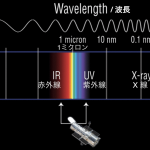
人間の眼は、我々の周囲の物が出している電磁波の一部分の狭い領域、「可視光線」の部分だけを観ているに過ぎない。宇宙に存在する星々、星雲、多くの銀河、が出す電磁波には、可視光線以外の帯域で、大量の情報を含んでいる。宇宙を観測する天体望遠鏡は、可視光線以外の電磁波帯域も観測できる。ハブル宇宙望遠鏡は、可視光線帯域と赤外線と紫外線帯域の一部を観測できる。(Human eyes see only a small portion of the range of radiation from the objects around us. We call the radiation as electromagnetic spectrum, and the part we can see “visible light”. The radiation comes from cosmic objects, key information is revealed by different parts of the electromagnetic spectrum. Telescopes are designed to capture different parts of this spectrum, providing more information than the human eye could detect on, as like the Hubble Space Telescope can provides.)
